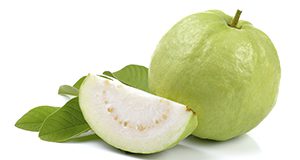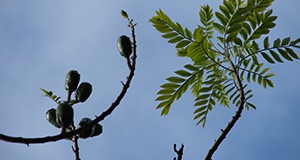The white Thai guava variety, which is very popular in the Asian market, is beginning to expand into mainstream markets. It has quick, high yields, is easily propagated and is tolerant to moisture stress and soil salinity. But even though it offers favorable returns, there has been little information about the cost of production. This 7-page fact sheet identifies inputs, costs, and yields considered to be typical of a well-managed five-acre Thai guava orchard in south Florida. Written by Stella Garcia, Edward A. Evans, and Jonathan Crane and published by the UF Department of Food and Resource Economics, August 2016.
http://edis.ifas.ufl.edu/fe998
Tag: Jonathan H. Crane
Spondias Growing in the Florida Home Landscape
Spondias species (whose common names among English speakers include ambarella, Ataheite apple, mombins, and hog plums) are flowering trees native to tropical and subtropical regions. They are known for their sweet fruit and grow well in the warmest parts of Florida. This 8-page fact sheet discusses biology, distribution and uses, as well as guidelines for propagation and maintenance. Written by Jonathan H. Crane and Jeffrey Wasielewski, and published by the UF Department of Horticultural Sciences, April 2015. (Photo by Forest & Kim Starr, CC BY 3.0)
http://edis.ifas.ufl.edu/mg059
SmartIrrigation Avocado App: A Step-by-Step Guide
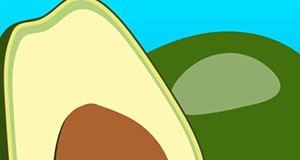 UF’s SmartIrrigation Avocado for iOS and Android platforms provides a simple ET-based method to schedule irrigation and is expected to provide 20% to 50% water savings based on findings with other schedule tools. This 6-page fact sheet provides configuration instructions and main menu features. Written by D. Mbabazi, K. W. Migliaccio, J. H. Crane, J. H. Debastiani Andreis, C. Fraisse, L. Zotarelli, and K. T. Morgan, and published by the UF Department of Agricultural and Biological Engineering, May 2015.
UF’s SmartIrrigation Avocado for iOS and Android platforms provides a simple ET-based method to schedule irrigation and is expected to provide 20% to 50% water savings based on findings with other schedule tools. This 6-page fact sheet provides configuration instructions and main menu features. Written by D. Mbabazi, K. W. Migliaccio, J. H. Crane, J. H. Debastiani Andreis, C. Fraisse, L. Zotarelli, and K. T. Morgan, and published by the UF Department of Agricultural and Biological Engineering, May 2015.
http://edis.ifas.ufl.edu/ae513
Establishment Cost of Avocados in South Florida
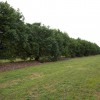 A major concern for the future of the Florida avocado industry is laurel wilt disease (LW), which is caused by fungus transmitted by the ambrosia beetle. Cost-effective management of LW relies heavily on the early detection and destruction of affected trees (sanitation). While not an official recommendation, some suggest that since the beetles are less attracted to younger trees, growers might consider leaving the young orchards in production while replanting only older and less productive orchards. Since the long-term survival of the Florida avocado industry may ultimately depend on a combination of eradication, prophylactic treatment, and replanting the trees, the purpose of this article is to provide an updated guidance on the costs of establishing an avocado orchard. Information presented in this study is based on interviews with growers, orchard service companies, extension agents, and other industry personnel. It is intended as a guide only to make production decisions, prepare budgets, and investigate insurance options. A follow-up document to this one will focus on the cost and return of maintaining an orchard after it has been established. This 9-page fact sheet was written by Braulia De Oleo, Edward A. Evans, and Jonathan H. Crane, and published by the UF Department of Food and Resource Economics, October 2014.
A major concern for the future of the Florida avocado industry is laurel wilt disease (LW), which is caused by fungus transmitted by the ambrosia beetle. Cost-effective management of LW relies heavily on the early detection and destruction of affected trees (sanitation). While not an official recommendation, some suggest that since the beetles are less attracted to younger trees, growers might consider leaving the young orchards in production while replanting only older and less productive orchards. Since the long-term survival of the Florida avocado industry may ultimately depend on a combination of eradication, prophylactic treatment, and replanting the trees, the purpose of this article is to provide an updated guidance on the costs of establishing an avocado orchard. Information presented in this study is based on interviews with growers, orchard service companies, extension agents, and other industry personnel. It is intended as a guide only to make production decisions, prepare budgets, and investigate insurance options. A follow-up document to this one will focus on the cost and return of maintaining an orchard after it has been established. This 9-page fact sheet was written by Braulia De Oleo, Edward A. Evans, and Jonathan H. Crane, and published by the UF Department of Food and Resource Economics, October 2014.
http://edis.ifas.ufl.edu/fe956
Costos Estimados en el 2010 para Establecer y Producir Pitaya (Fruta Dragón) en el Sur de Florida (FE921)
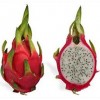 Como consecuencia de la creciente competencia extranjera y la disminución de rendimientos de los productos agrícolas tradicionales, muchos productores en el Sur de la Florida se han embarcado en una búsqueda agresiva de productos agrícolas que sean alternativas viables. Un producto que ha llamado la atención es la pitaya, una especie de cactus trepador autóctona de las regiones de bosques tropicales de México, Centroamérica y América del Sur. De menos de 50 hectáreas plantadas en la Florida en fecha tan reciente como 2006, la producción se ha multiplicado por seis y ahora se estima en alrededor de 320 acres. This 6-page fact sheet was written by Edward A. Evans, Jordan Huntley, Jonathan Crane, and Allen F. Wysocki, and published by the UF Department of Food and Resource Economics, March 2013.
Como consecuencia de la creciente competencia extranjera y la disminución de rendimientos de los productos agrícolas tradicionales, muchos productores en el Sur de la Florida se han embarcado en una búsqueda agresiva de productos agrícolas que sean alternativas viables. Un producto que ha llamado la atención es la pitaya, una especie de cactus trepador autóctona de las regiones de bosques tropicales de México, Centroamérica y América del Sur. De menos de 50 hectáreas plantadas en la Florida en fecha tan reciente como 2006, la producción se ha multiplicado por seis y ahora se estima en alrededor de 320 acres. This 6-page fact sheet was written by Edward A. Evans, Jordan Huntley, Jonathan Crane, and Allen F. Wysocki, and published by the UF Department of Food and Resource Economics, March 2013.
http://edis.ifas.ufl.edu/fe921
Estimacion de costos de establecimiento y produccion de papaya en el sur de la Florida en 2012 (FE920)
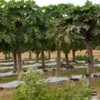 El alza reciente en los precios de la papaya, consecuencia de las restricciones fitosanitarias impuestas a la fruta proveniente de México, ha despertado el interés de productores en el Sur de la Florida, quienes han percibido la oportunidad de suplir la demanda por papaya madura en los Estados Unidos. No obstante, hay mucha incertidumbre con respecto a la viabilidad económica del negocio. El objetivo de este documento es proveer información acerca del retorno económico y los costos de producción de un cultivo de 5 acres de papaya en el Sur de la Florida. Igualmente, se evaluaron precios y rendimientos que permitirían que el negocio fuese rentable en el Sur de Florida. This 7-page fact sheet was written by Edward A. Evans, Fredy H. Ballen, y Jonathan H. Crane, and published by the UF Department of Food and Resource Economics, February 2013.
El alza reciente en los precios de la papaya, consecuencia de las restricciones fitosanitarias impuestas a la fruta proveniente de México, ha despertado el interés de productores en el Sur de la Florida, quienes han percibido la oportunidad de suplir la demanda por papaya madura en los Estados Unidos. No obstante, hay mucha incertidumbre con respecto a la viabilidad económica del negocio. El objetivo de este documento es proveer información acerca del retorno económico y los costos de producción de un cultivo de 5 acres de papaya en el Sur de la Florida. Igualmente, se evaluaron precios y rendimientos que permitirían que el negocio fuese rentable en el Sur de Florida. This 7-page fact sheet was written by Edward A. Evans, Fredy H. Ballen, y Jonathan H. Crane, and published by the UF Department of Food and Resource Economics, February 2013.
http://edis.ifas.ufl.edu/fe920
2012 Cost Estimates of Establishing and Producing Papaya (Carica papaya) in South Florida (FE918)
 With the recent spike in papaya prices due to phytosanitary restrictions on papayas from Mexico, many growers in South Florida are considering getting back into papaya production to target the ripe papaya market. Still, there are a lot of concerns as to whether the crop can be profitable in light of declining yields. Based on this discussion, the objective of this article is to provide needed information on the costs and returns associated with establishing and operating a five-acre papaya orchard in South Florida, and to assess the prices and yields that must be obtained to make a papaya orchard profitable. This 5-page fact sheet was written by Edward A. Evans, Fredy H. Ballen, and Jonathan H. Crane, and published by the UF Department of Food and Resource Economics, December 2012.
With the recent spike in papaya prices due to phytosanitary restrictions on papayas from Mexico, many growers in South Florida are considering getting back into papaya production to target the ripe papaya market. Still, there are a lot of concerns as to whether the crop can be profitable in light of declining yields. Based on this discussion, the objective of this article is to provide needed information on the costs and returns associated with establishing and operating a five-acre papaya orchard in South Florida, and to assess the prices and yields that must be obtained to make a papaya orchard profitable. This 5-page fact sheet was written by Edward A. Evans, Fredy H. Ballen, and Jonathan H. Crane, and published by the UF Department of Food and Resource Economics, December 2012.
http://edis.ifas.ufl.edu/fe918
An Overview of US Papaya Production, Trade, and Consumption (FE914)
![fe914 Figure 1. US fresh papaya imports by origin, 2002–2011 (metric tonnes [t]). Source: USDA/FAS (2012).](http://edis-news.ifas.ufl.edu/wp-content/uploads/2012/09/fe914-100x100.jpg) The United States produces close to 14,000 t of papaya annually. Consumption of the fruit is on the upswing and the development of new cultivars tolerant to the Papaya Ring Spot Virus encourage many growers in South Florida to taking a second look at producing papaya for the domestic market. This 8-page fact sheet provides information on domestic trends in the production and trade of fresh papaya in the U.S. Also included is a price analysis at the wholesale level for representative markets on the US East and West Coasts. Written by Edward A. Evans, Fredy H. Ballen, and Jonathan H. Crane, and published by the UF Department of Food and Resource Economics, September 2012.
The United States produces close to 14,000 t of papaya annually. Consumption of the fruit is on the upswing and the development of new cultivars tolerant to the Papaya Ring Spot Virus encourage many growers in South Florida to taking a second look at producing papaya for the domestic market. This 8-page fact sheet provides information on domestic trends in the production and trade of fresh papaya in the U.S. Also included is a price analysis at the wholesale level for representative markets on the US East and West Coasts. Written by Edward A. Evans, Fredy H. Ballen, and Jonathan H. Crane, and published by the UF Department of Food and Resource Economics, September 2012.
http://edis.ifas.ufl.edu/fe914
Ley del Estado de la Florida para el avalúo tributario de tierras según su uso: Preguntas y respuestas sobre la Clasificación Agropecuaria en el Condado de Miami-Dade (FE895)
 Use-value assessment is the most widely used technique in the United States today for maintaining land in agricultural production. Although general guidelines are provided to Florida counties on the application of the state’s use-value assessment law, counties may vary slightly in the application and determination of the agricultural land’s value. Therefore, it is important for agricultural landowners to understand the guidelines used to determine value in the county where the land is assessed and taxed. This 6-page factsheet applies specifically to Miami-Dade County, Florida. Written by Edward A. Evans, Mauricio Mosquera, Rodney L. Clouser y Jonathan Crane, and published by the UF Department of Food and Resource Economics, August 2011.
Use-value assessment is the most widely used technique in the United States today for maintaining land in agricultural production. Although general guidelines are provided to Florida counties on the application of the state’s use-value assessment law, counties may vary slightly in the application and determination of the agricultural land’s value. Therefore, it is important for agricultural landowners to understand the guidelines used to determine value in the county where the land is assessed and taxed. This 6-page factsheet applies specifically to Miami-Dade County, Florida. Written by Edward A. Evans, Mauricio Mosquera, Rodney L. Clouser y Jonathan Crane, and published by the UF Department of Food and Resource Economics, August 2011.
http://edis.ifas.ufl.edu/fe895
Florida’s Use-Value Assessment Law: Questions and Answers for Miami-Dade County Agricultural Classification (FE890)
Use-value assessment is the most widely used technique in the United States today for maintaining land in agricultural production. Although general guidelines are provided to Florida counties on the application of the state’s use-value assessment law, counties may vary slightly in the application and determination of the agricultural land’s value. Therefore, it is important for agricultural landowners to understand the guidelines used to determine value in the county where the land is assessed and taxed. This 5-page factsheet applies specifically to Miami-Dade County, Florida. Written by Edward A. Evans, Mauricio Mosquera, Rodney L. Clouser, and Jonathan Crane, and published by the UF Department of Food and Resource Economics, April 2011.
http://edis.ifas.ufl.edu/fe890
HS1153/HS402 Lemon Growing in the Florida Home Landscape
Revised! HS1153, a 13-page fact sheet by Jonathan Crane, provides homeowners with an overview of this small vigorous citrus fruit tree — description, propagation, fruit production, placement in the landscape, care, pest management, concerns with lawn care, harvest, ripening, and storage, use and nutrition. Includes references. Published by the UF Department of Horticultural Sciences, December 2010. http://edis.ifas.ufl.edu/hs402
FC47/CH092 Key Lime Growing in the Florida Home Landscape
Revised! FC47, a 12-page fact sheet by Jonathan Crane, provides homeowners with an overview of this small bushy citrus fruit tree introduced to the Americas by Spanish and Portuguese explorers in the sixteenth century — description, propagation, fruit production, placement in the landscape, care, pest management, concerns with lawn care, harvest, ripening, and storage, use and nutrition. Includes references. Published by the UF Department of Horticultural Sciences, December 2010.
http://edis.ifas.ufl.edu/ch092
FE888 2010 Cost Estimates of Establishing and Producing Pitaya (Dragon Fruit) in South Florida
FE888, a 7-page fact sheet by Edward A. Evans, Jordan Huntley, Jonathan Crane, and Allen F. Wysocki, provides needed information on the costs and returns associated with establishing and operating a five-acre pitaya orchard in South Florida, and assesses the prices and yields that must be obtained to make the establishment and production of a pitaya orchard a profitable venture. Published by the UF Department of Food and Resource Economics, December 2010.
http://edis.ifas.ufl.edu/fe888
FE838 Costos estimados de reemplazo de árboles de aguacate en plantaciones comerciales y patios en el sur de Florida
FE838, a 4-page fact sheet by Edward A. Evans and Jonathan H. Crane, is the Spanish language version of FE825 Estimates of the Replacement Costs of Commercial and Backyard Avocado Trees in South Florida. It discusses the projected costs to replace commercial and residential avocado trees in South Florida, due to the potential problems caused by the redbay-laurel wilt disease. Includes references. Published by the UF Department of Food and Resource Economics, June 2010.
http://edis.ifas.ufl.edu/fe838
HS1179 Homeowner Detection of and Recommendations for Mitigating Redbay Ambrosia Beetle-Laurel Wilt Disease on Redbay and Avocado Trees in the Home Landscape
HS1179, a 4-page illustrated fact sheet by Jonathan H. Crane and Jason A. Smith, provides homeowners with an update on redbay ambrosia beetle-laurel wilt disease in Florida, how the beetle and pathogen are spread, symptoms of infestations, and recommendations for homeowners. Includes references. Published by the UF Department of Horticultural Sciences, May 2010.
http://edis.ifas.ufl.edu/hs1179
AE456 Evapotranspiration-Based Irrigation for Agriculture: Crop Coefficients of Some Commercial Crops in Florida
AE456, a 4-page fact sheet by Isaya Kisekka, Kati W. Migliaccio, Michael D. Dukes, Jonathan H. Crane, and Bruce Schaffer, identifies typical Kc values for some of the crops commonly grown in Florida. Includes references. Published by the UF Department of Agricultural and Biological Engineering, January 2010.
http://edis.ifas.ufl.edu/AE456
AE458 Evapotranspiration-Based Irrigation for Agriculture: Implementing Evapotranspiration-Based Irrigation Scheduling for Agriculture
AE458, a 4-page fact sheet by Isaya Kisekka, Kati W. Migliaccio, Michael D. Dukes, Jonathan H. Crane, and Bruce Schaffer, outlines step-by-step procedures to follow when implementing a "smart" evapotranspiration (ET)-based irrigation schedule and a do-it-yourself irrigation schedule. Includes references. Published by the UF Department of Agricultural and Biological Engineering, January 2010.
http://edis.ifas.ufl.edu/AE458
AE457 Evapotranspiration-Based Irrigation Scheduling for Agriculture
AE457, a 6-page fact sheet by Isaya Kisekka, Kati W. Migliaccio, Michael D. Dukes, Jonathan H. Crane, and Bruce Schaffer, focuses on the main concepts related to ET-based irrigation scheduling and reviews the use of "smart" irrigation scheduling controllers for agricultural applications. Includes references. Published by the UF Department of Agricultural and Biological Engineering, January 2010.
http://edis.ifas.ufl.edu/AE457
AE455 Evapotranspiration-Based Irrigation for Agriculture: Sources of Evapotranspiration Data for Irrigation Scheduling in Florida
AE455, a 4-page fact sheet by Isaya Kisekka, Kati W. Migliaccio, Michael D. Dukes, Bruce Schaffer, Jonathan H. Crane, and Kelly Morgan, lists some of the public sources of ETo data for irrigation scheduling in Florida. Includes references. Published by the UF Department of Agricultural and Biological Engineering, January 2010.
http://edis.ifas.ufl.edu/AE455
ABE368/AE396 South Florida Tropical Fruit Grower Perspectives: Water Conservation Management Practices
Revised! ABE368, a 6-page fact sheet by Kati W. Migliaccio, Jonathan H. Crane, Edward Evans, Bruce Schaffer, Yuncong Li, and Rafael Muñoz-Carpena, presents results of fruit grower responses from a survey designed to assess changing views of agricultural producers in Miami-Dade county from 2006 to 2009 regarding water quantity and quality management practices — methods, demographics, water quality and quantity opinions concerning lifestyle, agriculture, and best management practices (BMPs). Includes references. Published by the UF Department of Agricultural and Biological Engineering, November 2009.
http://edis.ifas.ufl.edu/AE396
